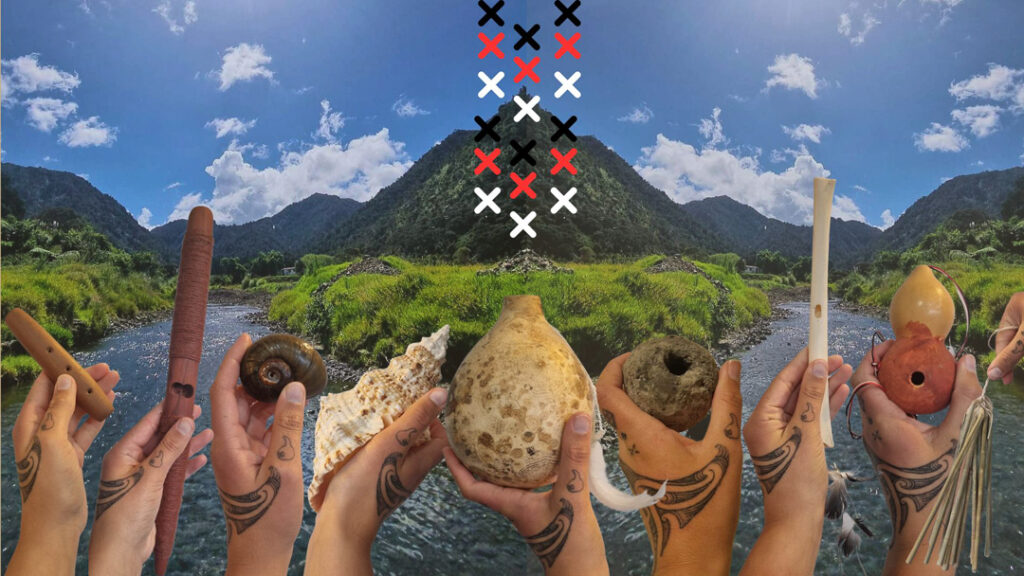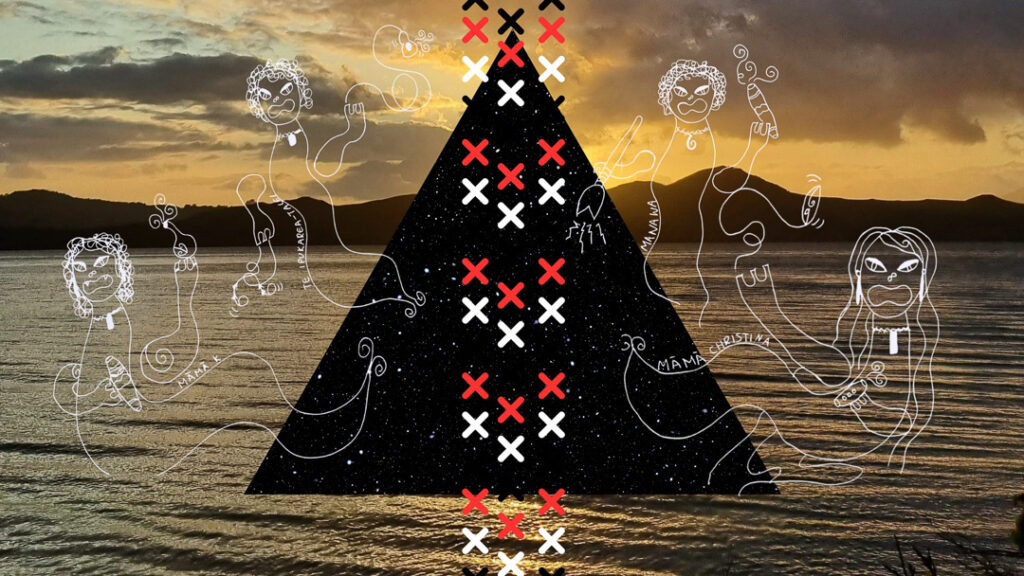
Waihou river, Panguru taken under Pūkepoto mountain, looking up towards Te Warawara forest. Image includes taonga pūoro; Kōauau made from rimu, Pūtorino made by Sam Palmer gifted by Te Ātea nui whānau, Pupurangi/Kauri snail shell, Bursidae shell, hue/gourd with Toroa feathers, uku tangi made from clay gathered on the Hokianga harbour, Toroa Kōauau with Toroa feathers, poi awhiowhio made from hue, and poi pui made from muka.
Karen Leef explains the profound meaning of the Māori wind instrument she plays, the kōauau.
(A mihi for the reader.)
He uri tēnei nō Te Rarawa, Ngā Puhi me Tau’tu Aitutaki
I tipu ake au ki Te Ukutoia, Tāmaki-Makaurau erangi, e noho ana au ki Te Whanaganui a Tara, Aotearoa.
Ko Karen Leef tōku ingoa
Taonga Pūoro to accompany the story
There is something about the darkness that makes me absolutely terrified and equally intrigued. When I think of darkness I think of the following; black, cold, silent and still. It wasn’t until I was in absolute darkness that I realised that te pō isn’t as silent or scary as I thought.
Te Kore is a place of infinite potential, of nothingness, and of beginnings. Nothingness isn’t always empty and beginnings don’t begin without an end.
It was at a time such as this, that I asked my ancestors for help. They came and took me deep into the whenua. I became like a child in the womb of their mother, hearing only the sound of the pahū, being playing in time with that of a beating heart, a place of infinite potential, a place of beginning.
Oro. Oho. Oranga.
My first experience with Taonga Pūoro was through my friend, Kaya. Kaya was a kaiako at my kids kōhanga. She would often share her knowledge and love for Taonga Pūoro with our tamariki. Our son Manawa was as expressive as any four-year-old, often too cool to listen to their Māmā. But when Whaea Kaya would play her kōauau, the mokopuna were immediately captivated by the sound, gathering at her feet to hear more.
My immediate thoughts when seeing this were, how did she calm my expressive four-year-old? And how can I get me a kōauau?
I found a shift in my spirit that couldn’t be denied. The sounds from these pūoro were familiar and comforting, like I’d heard them before. After seeing the power pūoro had with our babies, for which I am so thankful to my hoa Kaya, I made it my mission to learn and find out more about Taonga Pūoro. Like any inspired human, I went along to a Taonga Pūoro school holiday workshop at the library, alone, without my kids. I believe I was the only adult to go alone. I sat with the other kids and listened to a kōrero by Matua Sam Palmer and Jerome Kavangah. Just like my child, I was captivated particularly by the playing of a kōauau made from the tooth of a whale gifted to Matua Jerome. There I made my first bamboo kōauau and cardboard porotiti to which I spent the following months remembering, healing and playing my first pūoro. This was my beginning.

Sunset over Hokianga Whakapau Karakia, Te Tai Tokerau, Aotearoa. There is a starry portal in the middle with taaniko through the centre. There are illustrations of whānau Leef as pūoro wizards exiting the portal.
Te Oro. Te Kore. Te Ao Marama
A few years deep into my journey with Taonga Pūoro it has truly changed our lives. I can’t live without it. I had spent years using Western methods to heal. I swear I’ve read more self-help books than anyone, but nothing ever stuck. There is something special that happens when I play or hear Taonga Pūoro.
When I lift my kōauau up to play I feel the breath of Tāne Mahuta cascade within me. Kōauau transformed from native rākau in Aotearoa. Kōauau are often long cylinders made out of wood or bone. However, they can be made out of anything and take any form. Kōauau often have three wenewene/tone holes. Kōauau can also be played without any tone holes. I feel an immense sense of connection to kōauau made from native wood or bone. There is a kōrero that says “that pūoro made from the earth, from the trees or from people or animals will play the sound of whatever they have transformed from.” For many of my pūoro made from my whenua up home, they have become portals back to Te Tai Tokerau.
To play we must first be in a good relationship with ourselves and our pūoro or neither of us is going to sing a song that resonates. In saying this, there are pūoro that can be used to shift unwanted energy in ourselves or in our space. Because it can take so much energy to play some of the pūoro, you can often forget why you were sad or angry.
Oro, sound, are invitations from our atua to connect.
I felt this especially during my journey with Covid last year. Having a respiratory illness isn’t the easiest to have when you love your pūoro so much. Hue require a deep and continuous breath to play. It takes deep intention with your breath to get your hue to sing. You hold the hue between your hands as I blow across a hole cut along the top. This will create a deep chamber of sound as you blow into the belly of Hine Pū te hue. To this day I felt the playing of hue made a significant difference in regulating my breath and improving my wellbeing. I now use hue to help regulate my breath with anxiety, long covid, and stress.
Taonga Pūoro, unlike instruments, is all about relationships and energy. I spent most of my learning days frustrated with the sound I was creating. It didn’t sound “right” or “off-pitch”. But the perfect thing about pūoro is that there is no one sound for each pūoro. Each pūoro is going to be different, each rākau is going to be different, each bone pūoro is going to be different, each shell is going to be different and each person that plays is going to have a unique sound that is created from their relationship to that pūoro.
-
I had to decolonise what I understood sound and music to be. I had to turn on my Indigenous ear and appreciate the sounds of our environment, the sounds of our relationship with them as they are us. Only then could I unlock the full potential of my pūoro and in turn, myself.
It is very rare to find me without my pūoro these days. They are such an integral part of my life, my healing and I believe the healing of my people.
When I play my pūoro I feel the vibrations being cast throughout the generations to and from me, That’s how powerful I believe pūoro to be.
Although I am yet to converse fluently in my native tongue, Te Reo Māori, I believe that Taonga Pūoro is another language that I can speak and share what I cannot through words. This is an encouraging and powerful tool for Tangata Whenua on their language reclamation journey. In the future, I hope to see more pūoro in the homes of our Tangata Whenua. To hear pūoro being played at the marae, in our kura, with our mokopuna, during birth and death. I want to see pūoro be a taonga Māori want just as much as a Pounamu or kakahu and create ways they can incorporate them into their hauora and the rituals of their hapu.
I hope the holders of knowledge continue to share as generously as they do, the knowledge of taonga pūoro with all of our whānau Māori. The ones that need it, the kaumatua that want it, the whānau who can’t afford it, the ones only reading about pūoro in books and our mokopuna to come. Pūoro are taonga that can heal generations, why wouldn’t we want it to be as accessible as it can be?
I am thankful to the tuakana on whose shoulders I stand. The ones who held on to knowledge passed down and made it their mission to revive our relationship with pūoro. My tuakana, the incredible Taonga Pūoro wizards at Te Ātea Nui Pūoro Orchestra have so generously and lovingly held safe space for whānau to venture into the world of pūoro, Tamihana Katene, Rikki Peihana, Isaac Te Awe, Mikaere Berryman, Sam Palmer, Al Fraser and whānau. I acknowledge and uplift all the generations of kaitiaki that have lovingly passed down matauranga to you and that you continue to share with the world.
The pūoro king wizards Te Kahureremoa Taumata and Khali-Meari Mateora are the visionaries behind Te Ātea Nui Pūoro Orchestra. There is nothing more powerful than an Indigenous woman who knows who they are and the greatness they hold. Thank you for calling forth a calvary of Wahine Pūoro players and empowering our mana tamariki to be great players and kaitiaki of Taonga Pūoro.
To all the Pūoro Māreikura past and present with fire in their belly and aroha in their hearts, out here bringing the healing sounds of pūoro to our people; Ruby Solly, Kaya Edginton, Ariana Tikao and the late Whaea Hinewirangi Kohu-Morgan, to name only a few of the incredible Māreikura leading incredible change. E mihi nui ana ki a koutou.
My journey with Taonga Pūoro is a whānau affair. From healing, playing or making pūoro to my constant video calls sharing mātauranga; I journey this alongside our tamariki Manawa and Te Ipukarea-Talei, my sister Christina Leef and my Papā David Leef. He aroha mutunga kore ki a koutou.
We are not learning, we are remembering the greatness that we hold and descend from.

Our first pūoro is ourselves.
Tihei Mauri ora!
About Karen Leef
 Driven by her Māori, Aitutaki whakapapa, Karen is multidisciplinary creative from Te Tai Tokerau based in Te Whanganui a Tara, Aotearoa. Passionate about reclamation and uplifting the mana of Indigenous people she creates provocative statement pieces that tell captivating stories about her journey navigating two worlds, Te Ao Māori and Te Ao Pākēhā. Her creative practice is a celebratory fusion of; poetry, weaving, Taonga pūoro and recently, Whakairo. Guided by her ancestors, she stands on the shoulders of incredible Rangatira who empower her to stand in the fullness of her whakapapa. She is a Māmā, a sister, a daughter, a kaitiaki, a dreamer and a haututū, weaving words upon pūoro melodies calling her people home.
Driven by her Māori, Aitutaki whakapapa, Karen is multidisciplinary creative from Te Tai Tokerau based in Te Whanganui a Tara, Aotearoa. Passionate about reclamation and uplifting the mana of Indigenous people she creates provocative statement pieces that tell captivating stories about her journey navigating two worlds, Te Ao Māori and Te Ao Pākēhā. Her creative practice is a celebratory fusion of; poetry, weaving, Taonga pūoro and recently, Whakairo. Guided by her ancestors, she stands on the shoulders of incredible Rangatira who empower her to stand in the fullness of her whakapapa. She is a Māmā, a sister, a daughter, a kaitiaki, a dreamer and a haututū, weaving words upon pūoro melodies calling her people home.Glossary
- Aroha – Love
- Atua – god
- Hapū – clan
- Hue – gourd
- Kākahu – cloak
- Kōauau – flute
- Mātauranga – learning
- Oranga – life
- Porotiti – a musical instrument made of a disk spinning on a string
- Rākau – tree
- Rongoāoro – healing sound
- Tamariki – children
- Tāne Mahuta – the god who created forests and provided life.
- Te Kore – state of emptiness and pure potential that preceded the world.
- Te pō – the night/under world
- Tuakana – older sibling
Tags



Comments
“Tāne Mahuta”